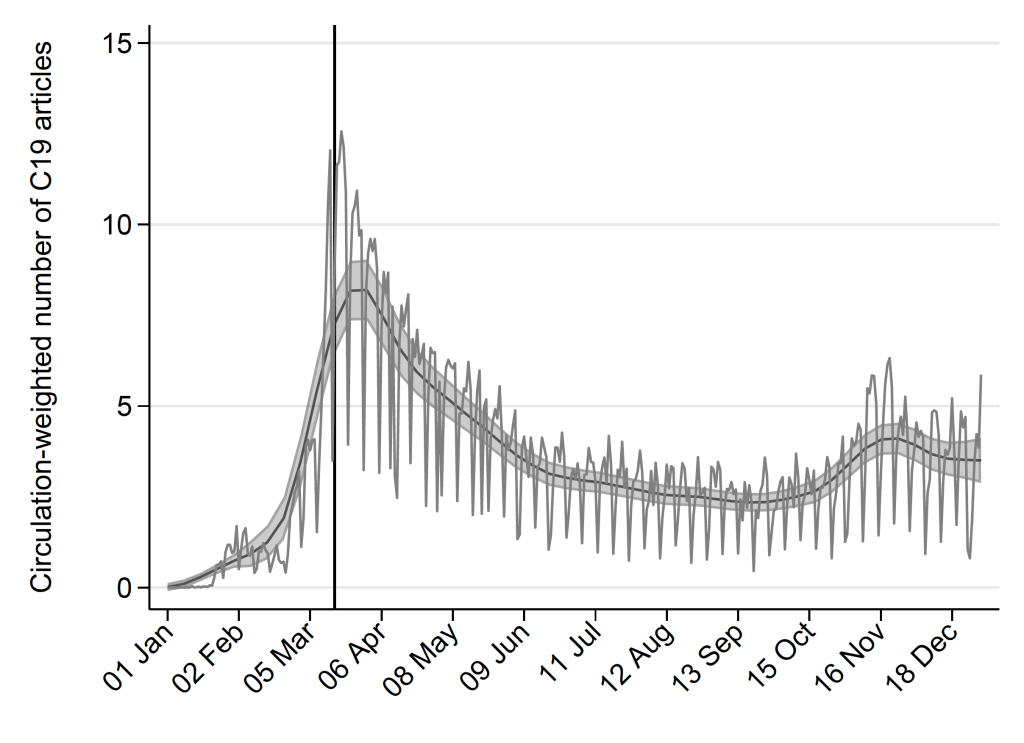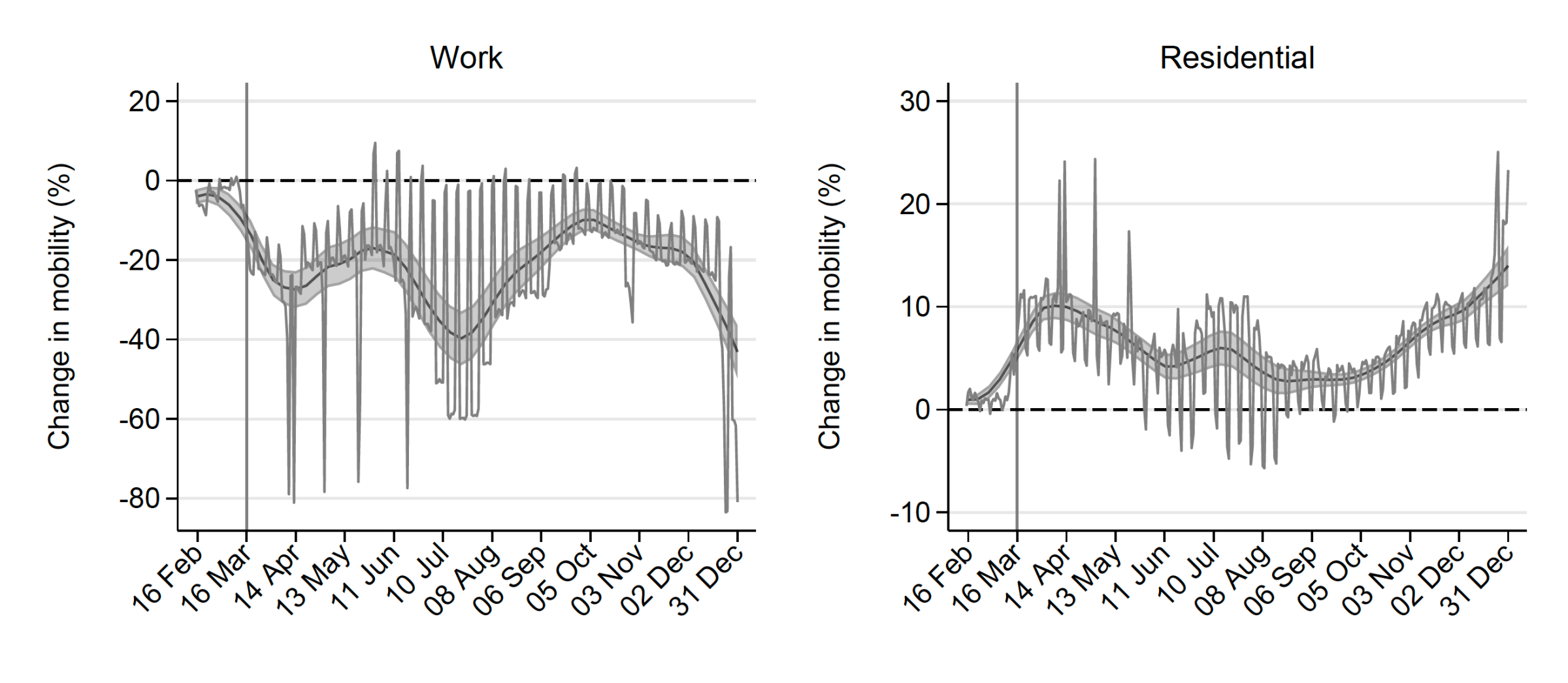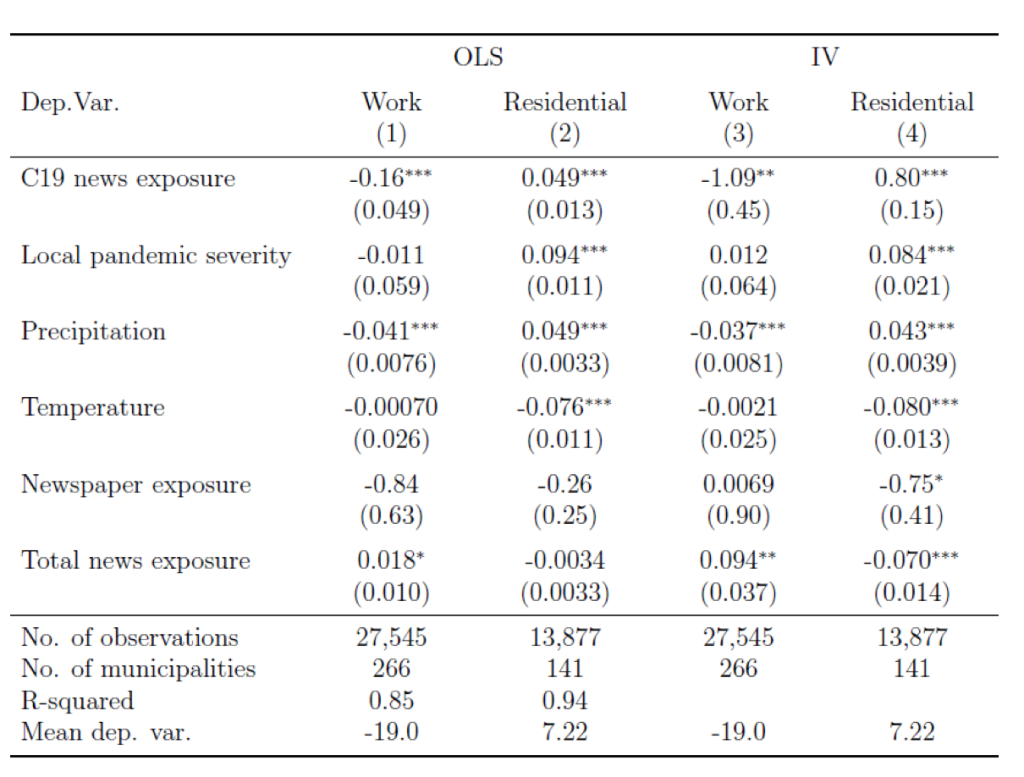Media coverage and pandemic behaviour: Evidence from Sweden
Individual behaviour can often have wider societal consequences and it is important to understand how to affect positive behavioural change. In this policy brief, we document the ability of the media to increase pro-social behaviour during a public health crisis. In Garz and Zhuang (2022), we collect a unique dataset of 200,000 newspaper articles about the Covid-19 pandemic from Sweden – one of the few countries that did not impose mandatory lockdowns or curfews but largely relied on voluntary social distancing. We show that mentions of Covid-19 significantly lowered the number of visits to workplaces and retail and recreation areas, while increasing the duration of stays in residential locations. The impacts are largest when Covid-19 news stories were more locally relevant, more visible and contained simple and explicit public health advice. These results have wider implications for the design of public communications and the value of the local news media.
The Covid-19 pandemic had devastating health and economic consequences for the entire world (see, for instance, the COVID19 | FREE Network Project for more information on the pandemic experience of the FREE network countries). To stop the spread of the virus, many governments imposed curfews or lockdowns. These mandatory restrictions on people’s movements were and remain controversial. In several countries, these public health policies fuelled conspiracy theories and led to protests and refusals to adopt other protective measures, such as wearing face masks. The policies have also been criticised for placing the burden disproportionately on the poorest members of society, many of whom lost their livelihoods due to the restrictions.
Sweden is one of few countries in the world that did not to impose any lockdowns or curfews. Instead, the Swedish strategy relied on voluntary compliance with public health recommendations aimed at reducing mobility and encouraging social distancing (for FREE policy briefs featuring in-depth discussions of the Swedish pandemic response and experience, see Becker et al., 2020; Hauser, 2020a; Hauser, 2020b; Campa, Roine and Strömberg, 2021; Berlin, 2020.) This strategy was by and large effective, with Sweden seeing similar falls in average mobility in 2020 compared to its Scandinavian neighbours which however imposed strict lockdowns.
What are the drivers of voluntary compliance? A recent SITE working paper “Media Coverage and Pandemic Behaviour: Evidence from Sweden” by Marcel Garz (Jönköping University) and Maiting Zhuang (SITE, Stockholm School of Economics) sheds light on this question. We show that news coverage of the pandemic could have played an important role in shaping public opinion, social norms and ultimately individuals’ health-related actions in Sweden. In this brief, we summarise our approach and findings, and discuss important policy insights.
Data
We collect close to 200,000 newspaper articles about Covid-19 from Swedish newspapers during 2020, which represents almost all newspaper coverage of the pandemic during that year in Sweden. Newspapers remain a major source of information in Sweden, where close to two thirds of the population are regular newspaper readers. We analyse the full texts of articles to identify which aspects of news coverage have the largest impact on behaviour. Figure 1 shows Covid-19 coverage in Swedish newspapers in 2020.
Figure 1. Newspaper coverage of Covid-19

Source: Retriever and authors’ calculations. This graph shows the number of articles including “coronavirus* OR covid*” on a given day, weighted by newspaper circulation. The grey solid lines are local polynomial smooths with 95 percent confidence intervals.
As our main outcome variable, we use Google Community Mobility Report data – anonymous data on the number (or duration) of visits to different types of locations (such as retail and recreation, workplaces, or residential) within a municipality.
Figure 2. Workplace and residential mobility

Source: Google and authors’ calculations. These graphs show the daily percentage change in mobility compared to median values between January 3 to February 6, 2020. The grey solid lines are local polynomial smooths with 95 percent confidence intervals.
Method
We want to study whether reading news concerning Covid-19 affected people’s decisions to reduce their own mobility in Sweden. However, determining the effect of the media on behaviour is difficult for several reasons. First, people choose what media to consume and most often tend towards media outlets that confirm their existing views. Second, there could be factors that determine both media coverage and behaviour.
In our paper, we address the first concern by carefully choosing our data. If we found that people who read more about Covid-19 in newspapers are also more likely to reduce their mobility, this could be driven by many different individual factors, such as how worried a person is about the pandemic. Instead, we measure exposure to Covid-19 news using data on the number of subscriptions every newspaper sells in each municipality. As newspaper subscriptions are annual and were decided before the pandemic, this measure of Covid-19 news exposure should not be correlated with individuals’ beliefs about the pandemic.
The second concern is more relevant, as it is likely that media coverage and individual mobility are both driven by the spread of the pandemic. To alleviate this concern, we adopt several strategies. The first is that we take into account local pandemic severity using a range of different measures, including excess deaths, infections, Covid-19 deaths at different geographic units and with different time lags.
Our second strategy relies on the fact that Swedish newspapers typically circulate in multiple municipalities, but are more likely to respond to events in municipalities where more of their subscribers live. We use an instrumental variable (IV) approach where we use the circulation-weighted excess mortality in a newspaper’s distribution area as the IV. This IV is a strong predictor for the amount of Covid-19 coverage by that newspaper but should not affect mobility in a target municipality – conditional on the pandemic severity in the municipality itself. We also show that our results hold in a sample of “peripheral” municipalities, that is municipalities that only form a small percentage of any newspaper’s subscriber base, but where these newspapers are nonetheless major sources of information.
Results
We find evidence that media coverage of the pandemic increases compliance with the main public health recommendation to work from home in Sweden. More newspaper articles about Covid-19 on a given day and in a given municipality is associated with increased residential mobility and lower workplace mobility (Table 1), as well as fewer visits to retail areas and recreational facilities. This pattern remains even when controlling for the severity of the pandemic at the local level. The results are robust using different methods and data.
Table 1. Effect of Covid-19 coverage on workplace and residential mobility

Source: Retriever, Google, SMHI, MPRT and authors’ calculations. Observations are at the municipality-day level. The dependent variables are percentage changes in Google mobility for workplaces (columns 1 and 3) and residential areas (columns 2 and 4) relative to the baseline. The main regressor is the circulation-weighted number of Covid-19 articles. Columns 3 and 4 show IV results using the interaction between weighted excess deaths across a newspaper’s circulation area and newspaper exposure as the IV. Local pandemic severity is the latest available excess deaths figure in the municipality at the time of newspaper publication. All regressions control for municipality and day fixed effects. Standard errors in parentheses are clustered by municipality. Significance at the 1%, 5% and 10% is denoted by ***, ** and *, respectively.
The type of coverage matters. Behaviour responds the most to personally relevant news that is easy to understand and visible. In particular, Covid-19 articles which explicitly mention the affected municipality have a larger impact on mobility than, for instance, articles that only relate to developments abroad. There are larger impacts of more factual compared to more subjective reporting. Articles that contain direct and explicit public health advice have a large impact on individual behaviour. In contrast, articles that mention medical experts have a smaller impact on individual behaviour – likely due to the complexity of the language used.
We also find a greater impact on individual behaviour in response to more visible Covid-19 stories, such as articles on the front page or articles whose headlines mention the pandemic. These results are consistent with media coverage not just increasing the salience of the pandemic and reminding individuals to follow official guidelines, but also providing relevant information. Despite fears that the large amount of press coverage could lead to individuals avoiding news about the pandemic, we find little evidence for media fatigue except at very high levels of coverage.
Conclusion
In Garz and Zhuang (2022), we study the effects of media coverage on individual behaviour during a public health crisis. We focus on Sweden, a country that did not impose any lockdowns or curfews during the Covid-19 pandemic and where newspapers remain an important source of information. Using close to the universe of all Swedish newspaper articles about Covid-19 in 2020, we find that media coverage of the pandemic encouraged people to stay at home. The effect is largest when news stories are of local relevance and contain explicit public health advice. These results have important implications for the design of future public communication strategies that aim to foster behavioural change.
We also find little evidence of media fatigue or a preference of opinion pieces relative to factual reporting when it comes to Covid-19 in Sweden. While there has been much discussion about misinformation and media bias during the pandemic, our paper shows a positive effect of the local news media in terms of encouraging voluntary adherence to public health measures.
More broadly, our study adds an important dimension to the policy discussion about the decline of local news, beyond local political accountability and community participation. We find that local news remains an important source of local information, and that personally relevant information is more important for behavioural change. A lack of trusted local media could adversely affect compliance with government recommendations during a crisis, as well as a range of other campaigns, such as those encouraging the take-up of vaccines or adoption of more environmentally friendly behaviours.
References
Disclaimer: Opinions expressed in events, policy briefs, working papers and other publications are those of the authors and/or speakers; they do not necessarily reflect those of SITE, the FREE Network and its research institutes.
Photo by zimmytws, Shutterstock.com




